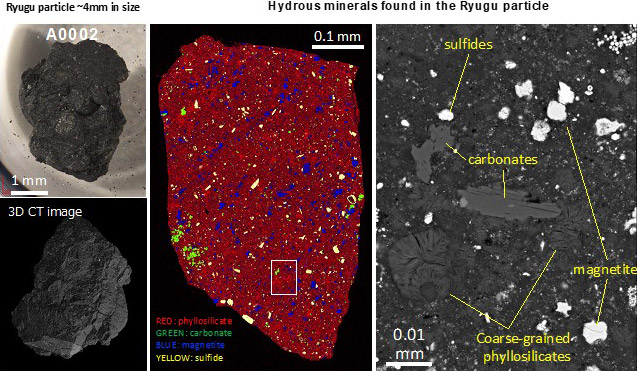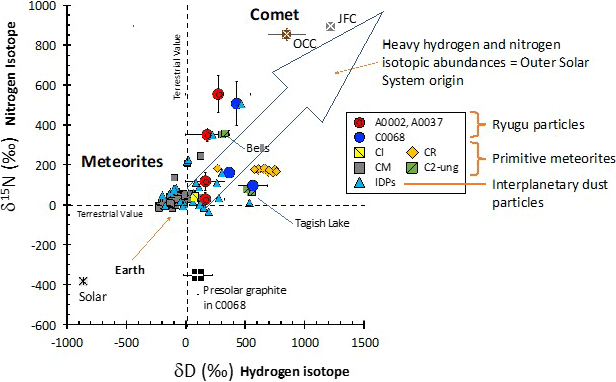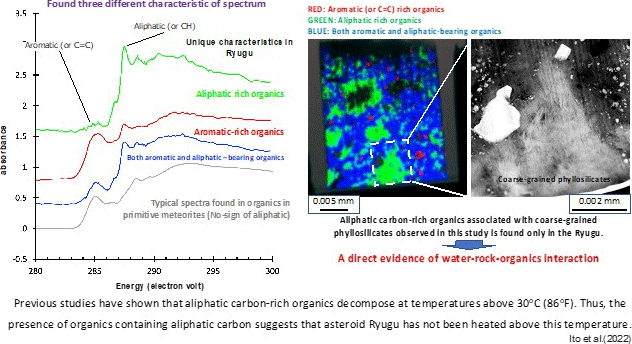National Institute of Polar Research
Asteroid Ryugu is a drifter from the outer Solar System:
Results from the Hayabusa2 Phase-2 Curation Kochi Team published in Nature Astronomy
Published on August 16, 2022
Posted on August 18, 2022
Japan Aerospace Exploration Agency (JAXA)
Japan Agency for Marine-Earth Science and Technology (JAMSTEC)
Japan Synchrotron Radiation Research Institute (JASRI)
National Institute of Polar Research
Institute for Molecular Science
KANAGAWA UNIVERSITY
The Open University
Osaka University
Ritsumeikan University
Nagoya University
The Japan Aerospace Exploration Agency (JAXA) has just completed the first year of its analytical campaign on samples returned from asteroid Ryugu. These cutting-edge studies have been undertaken by two Phase-2 curation teams (the Kochi Institute for Core Sample Research, Japan Agency for Marine-Earth Science and Technology, JAMSTEC and Okayama University) and six sub-teams of the Initial Analysis Team.
We are pleased to announce that a journal article summarizing the results of the Phase-2 Kochi Team has been published in “Nature Astronomy” on August 16, 2022 (JST).
- Title:A pristine record of outer Solar System materials from asteroid Ryugu's returned sample
- Journal: Nature Astronomy
- DOI: 10.1038/s41550-022-01745-5
Please see the attached sheet for a summary of the study.
Initial analysis of the asteroid Ryugu sample
The sample from asteroid Ryugu returned to Earth by the asteroid explorer, Hayabusa2, on December 6, 2020, initially underwent a cataloguing description (Phase-1 curation) at the facility established at JAXA’s Institute of Space and Astronautical Science. Part of the returned sample was distributed to the Hayabusa2 Initial Analysis Team, consisting of six sub-teams, and two Phase-2 curation institutes at Okayama University and JAMSTEC Kochi Institute for Core Sample Research. The initial analysis is designed to reveal the multifaceted features of the sample through a plan of high-precision analysis, with specialized sub-teams assigned to tackle the science objectives of the Hayabusa2 mission. Meanwhile, the Phase-2 curation institutes have specific specialties that are utilized to catalogue the sample based on a comprehensive analysis flow, and clarify the potential impact of the sample through measurement and analysis appropriate to the characteristics of the returned particles.
Reports from the six teams involved in the initial analysis, as well as those from Okayama University and JAMSTEC Kochi Institute for Core Sample Research, will be announced separately as the results are published in scientific journals. After the initial results have been released, a new overall summary of the Hayabusa2 science is planned.
[attached sheet]
Asteroid Ryugu: A drifter from the outer Solar System region
- Geochemistry and isotopic evidence from organic and phyllosilicate-rich material
The Phase-2 curation [*1] Kochi Team, led by Motoo Ito of the Extra-cutting-edge Science and Technology Avant-garde Research (X-star), Kochi Institute for Core Sample Research, JAMSTEC, began analysis of Ryugu particles on June 20, 2021. The results of the first-year analytical campaign, based on systematic investigations conducted at institutes and universities across Japan, the USA, and the UK, has been published in Nature Astronomy on August 15, 2022 (August 16, JST).
1. The mineralogy of the Ryugu particles indicate that they underwent extensive aqueous alteration.
2. The deuterium-rich and 15N-rich isotopic compositions of fine-grained minerals and organics suggest that the constituents of the Ryugu particles formed in the outer Solar System.
3. Aliphatic carbon-rich organics associated with coarse-grained phyllosilicates were found. Such an association has not been observed in any meteorite study and could be unique to the asteroid Ryugu.
4. The results suggest that coarse-grained phyllosilicates may have served as “cradles” for organics and water, which may subsequently have been transported to the early Earth.
Background
Earth's materials have experienced continuous modification due to geological processes that have operated throughout its history; as a result, much of the information about its primordial composition has been lost. Primitive asteroids preserve the earliest evidence of how and when our Solar System formed. Fragments from these asteroids are delivered to Earth as meteorites and space scientists have long been studying these materials to decipher the 4.6-billion-years-history of our Solar System. However, there is a problem. During atmospheric entry the chemical composition of meteorites is altered by interaction with the Earth’s atmosphere. Any delays in collecting the samples results in further changes, generally referred to as terrestrial weathering. By collecting samples directly from asteroid Ryugu and delivering them to Earth free from terrestrial contamination, the JAXA Hayabusa2 mission has provided scientists with the opportunity to study contamination-free, primitive samples for the very first time. Therefore, we are able to obtain the freshest chemical characteristics to elucidate the formation history of the early Solar System and the origins of water and the evolution of organics that likely were the building blocks for life on Earth.
The Hayabusa2 spacecraft was launched by JAXA on December 3, 2014, and arrived at asteroid Ryugu to perform close-proximity spectroscopic observations; samples were successfully collected twice from different locations. The capsule containing samples was recovered on December 6, 2020, in the Woomera Desert, South Australia. A total of approximately 5.4 grams of dark black particles were identified in the capsule. Researchers at the Extraterrestrial Sample Curation Center (ESCuC) of JAXA performed the initial description of these particles, the results of which were published in November of 2021 (Yada et al., 2021; Pilorget et al., 2021). Two Phase-2 curation teams and the six Initial Analysis sub-teams began work on the Hayabusa2 samples in June 2021. Beginning in June of 2022, their initial results have started to be published in international, high-impact, scientific journals.
Outcome
The Phase-2 curation Kochi Team has been working with JAXA curation since 2015 to improve sample storage and transportation, analytical techniques of extraterrestrial materials, and curatorial activities. In mid-June of 2021, eight Ryugu particles (four from chamber A, four from chamber C; particles have a diameter of 1–4 mm), approximately 50 mg in total, were allocated to the Kochi Team. The X-ray computed tomography (CT) imaging was performed at the SPring-8 synchrotron radiation facility to assess the three-dimensional shapes and internal structures of individual particles and to determine the regions-of-interests for subsequent analyses. The particles were then transported to domestic and international research institutes without exposure to the Earth’s atmosphere. With the cooperation of the British Embassy in Japan, the Ministry of Education, Culture, Sports, Science and Technology of Japan, and the Ministry for Foreign Affairs of Japan, the samples were safely and quickly transported to the Open University, UK and the Department of Earth, Planetary, and Space Sciences, University of California, Los Angeles (UCLA), USA.
The bulk elemental abundances and the oxygen isotopic composition of the particles analyzed by the Kochi team are consistent with those reported by Yokoyama et al. (2022, Science) and E. Nakamura et al. (2022, Proceedings of the Japan Academy, Ser. B, Physical and Biological Sciences). We have concluded that asteroid Ryugu is composed of material that is representative of the average elemental abundances of our Solar System. Mineral assemblages in the Ryugu particles are consistent with having formed in the presence of water (Figure 1.), suggesting that ice (water) existed on/within the Ryugu parent body in the past and that the minerals formed as a result of the reaction between water (liquid) and the original minerals.

Figure1. Petrography of Ryugu particles. (Top left) Largest allocated Ryugu particle (A0002); (bottom left) synchrotron X-ray based CT image of A0002 obtained at the SPring-8 facility; (middle) False-color X-ray elemental image. Mineral assemblages formed in the presence of water, red: phyllosilicates, green: carbonates, blue: magnetite, yellow: sulfides; (right) High resolution back-scattered electron image. Area enlarged from the white box in the middle panel. Image: Modified from Ito et al. (2022)
Analyses of ultra-thin sections from the Ryugu particles utilizing a nanoscale secondary ion mass spectrometer (NanoSIMS, *2) revealed that the hydrogen and nitrogen isotopic compositions are enriched in the heavier isotopes compared to that on Earth and in meteorites (Figure 2). The distributions of isotopic compositions of Ryugu show some similarities to those of interplanetary dust particles. The material from which asteroid Ryugu formed originated in the outer Solar System, and while it experienced significant aqueous alteration on its parent asteroid, it has never been significantly heated and so retains its primitive characteristics.

Figure 2. Nitrogen and hydrogen isotopic composition of Ryugu particles compared to various extraterrestrial materials. This data suggests that the Ryugu particles were formed in the outer Solar System. Image: Modified from Ito et al. (2022)
Correlated analysis utilizing a scanning transmission X-ray microscopy (STXM, *3) and an ultra-high resolution transmission electron microscope (TEM, *4) revealed that aliphatic carbon-rich organics [*5] are present in a complex microstructure with coarse-grained phyllosilicates in a Ryugu particle [*6] (Figure 3). This is a “first-of-its-kind find” and provides direct evidence of water-mineral-organics interaction on an asteroid. Previous studies have shown that aliphatic carbon-rich organics decompose at temperatures above 30°C (86°F). Thus, the presence of organics containing aliphatic carbon suggests that asteroid Ryugu has not been heated above this temperature. Further studies are currently being conducted to clarify the structures and chemical compositions of the organic matter.

Figure 3. (Left) An ultra-thin section of 20-μm2 Ryugu particle analyzed by STXM. Organics have different functional groups. (Right) A TEM image of the area of the dashed lines in the left panel. Aliphatic carbon-rich organics are concentrated in the coarse-grained phyllosilicates. So far, this occurrence has only been seen in this Ryugu particle and serves as direct evidence of interactions between minerals and organics in an aqueous-rich environment. Image: Modified from Ito et al. (2022)
Future outlook
Coarse-grained phyllosilicates in the Ryugu particles are one potential source of organics and water to the inner Solar System, including the early Earth. The organics in the coarse-grained phyllosilicates are more resistant to decomposition than those in fine-grained phyllosilicates and may have been transported to Earth in their original state. The Ryugu particles, however, have heavier hydrogen isotopic compositions than those found on Earth, indicating that Ryugu-type asteroids may not be the only source of volatiles to the early Earth. In particles from the asteroid Itokawa, silicate minerals that shows a light hydrogen isotopic composition due to solar wind implantation have also been found (Daly et al., 2021). The water on Earth may have formed from mixed components with various hydrogen isotopic compositions. The following hypotheses could be formulated based on the results of the present study:
1.Asteroid Ryugu accreted some components that originated in the outer Solar System and contained abundant water and organics. The asteroid then traveled to the inner Solar System.
2.Organics associated with coarse-grained phyllosilicates may serve as one of the potential sources of water and organics to the Earth.
Further analyses of the Ryugu particles and of asteroid Bennu by the OSIRIS-REx Mission of the US National Aeronautics and Space Administration (NASA) will allow us to test these hypotheses further.
Supplemental information
*1 Phase-2 curation (Kochi Team)
The ESCuC was established at the ISAS/JAXA primarily for the curation activities of return samples from extraterrestrial bodies after the “Hayabusa” missions. For the “Hayabusa2” mission, the Phase-2 curation team were organized by the ESCuC of JAXA and two institutes were authorized by the curation steering committee in 2017. One of the Phase-2 curation teams was proposed by Kochi Institute for Core Sample Research (KOCHI), JAMSTEC in collaboration with JASRI/SPring-8, UVSOR Synchrotron Facility/National Institutes of Natural Sciences, Institute for Molecular Science, and National Institute of Polar Research (NIPR). This team is working in collaboration with the ESCuC to develop sample distribution containers, transportation/transfer equipment, and analytical techniques for curation activities in an atmosphere-free environment. Another objective of the Kochi Team is to maximize the scientific results based on samples from the asteroid Ryugu by improving the description of the “Hayabusa2” samples using the advanced analytical techniques developed at each institution.
*2 Nanoscale secondary ion mass spectrometry (NanoSIMS)
This mass spectrometer allows visualization of the distribution of elements (e.g., carbon, nitrogen, hydrogen, and oxygen) or their isotopes in the sample with a primary ion beam of 50–100 nm. One nanometer (nm) is one-billionth of one meter.
*3 Scanning transmission X-ray microscopy (STXM)
This technique visualizes X-ray absorption spectra at a high resolution by scanning a thin film sample with an X-ray micro beam (30–150 nm) of varying wavelengths. In analyses of organic matter, soft X-ray synchrotron radiation is used to measure the X-ray absorption near the absorption edge of the constituent element (carbon in this study).
*4 Ultra-high resolution transmission electron microscopy (TEM)
This electron microscope accelerates electrons at a high voltage, which are then irradiated on to a thin film sample. The transmitted and scattered electrons produce magnified images of the sample (from thousands to millions of times magnification). The X-ray analyzer attached to the electron microscope allows elemental analysis at submicron spatial resolution.
*5 Organics containing aliphatic carbon
Organics contain aliphatic carbon in the form of linear, branched, or non-aromatic rings with carbon atoms. Examples include methane, ethylene, paraffinic hydrocarbons, and acetylene.
*6 Hydrous silicate minerals
A silicate mineral contains structural water between sheet structures, as typified by serpentine and saponite.
Original article:
Journal: Nature Astronomy
Title: A pristine record of outer Solar System materials from asteroid Ryugu's returned sample
Authors:
Motoo Ito1*, Naotaka Tomioka1, Masayuki Uesugi2, Akira Yamaguchi3,4, Naoki Shirai5,¥, Takuji Ohigashi4,6,¥¥, Ming-Chang Liu7, Richard C. Greenwood8, Makoto Kimura3, Naoya Imae3,4, Kentaro Uesugi2, Aiko Nakato9, Kasumi Yogata9, Hayato Yuzawa6, Yu Kodama10,$, Akira Tsuchiyama11,12,13, Masahiro Yasutake2, Ross Findlay8, Ian A. Franchi8, James A. Malley8, Kaitlyn A. McCain7, Nozomi Matsuda7, Kevin D. McKeegan7, Kaori Hirahara14, Akihisa Takeuchi2, Shun Sekimoto15, Ikuya Sakurai16, Ikuo Okada16, Yuzuru Karouji17, Masahiko Arakawa18, Atsushi Fujii9, Masaki Fujimoto9, Masahiko Hayakawa9, Naoyuki Hirata18, Naru Hirata19, Rie Honda20,$$, Chikatoshi Honda19, Satoshi Hosoda9, Yu-ichi Iijima†, Hitoshi Ikeda9, Masateru Ishiguro21, Yoshiaki Ishihara17, Takahiro Iwata9, Kosuke Kawahara9, Shota Kikuchi22, Kohei Kitazato19, Koji Matsumoto23, Moe Matsuoka9, Tatsuhiro Michikami24, Yuya Mimasu9, Akira Miura9, Osamu Mori9, Tomokatsu Morota25, Satoru Nakazawa9, Noriyuki Namiki23, Hirotomo Noda23, Rina Noguchi26, Naoko Ogawa9, Kazunori Ogawa9, Tatsuaki Okada9, Chisato Okamoto†, Go Ono9, Masanobu Ozaki4,9, Takanao Saiki9, Naoya Sakatani27, Hirotaka Sawada9, Hiroki Senshu22, Yuri Shimaki9, Kei Shirai9, Seiji Sugita25, Yuto Takei9, Hiroshi Takeuchi9, Satoshi Tanaka9, Eri Tatsumi28, Fuyuto Terui29, Ryudo Tsukizaki9, Koji Wada22, Manabu Yamada22, Tetsuya Yamada9, Yukio Yamamoto9, Hajime Yano9, Yasuhiro Yokota9, Keisuke Yoshihara9, Makoto Yoshikawa9, Kent Yoshikawa9, Ryota Fukai9, Shizuho Furuya9,25, Kentaro Hatakeda10, Tasuku Hayashi9, Yuya Hitomi10, Kazuya Kumagai10, Akiko Miyazaki9, Masahiro Nishimura9, Hiromichi Soejima10, Ayako Iwamae10,$$$, Daiki Yamamoto9,30, Miwa Yoshitake9,$$$$, Toru Yada9, Masanao Abe9, Tomohiro Usui9, Sei-ichiro Watanabe31, and Yuichi Tsuda4,9
Affiliation:
[1] Kochi Institute for Core Sample Research, X-Star, Japan Agency for Marine-Earth Science Technology (JAMSTEC), Nankoku, Kochi 783-8502, Japan
[2] Japan Synchrotron Radiation Research Institute (JASRI/SPring-8), 1-1-1 Kouto, Sayo, Hyogo 679-5198, Japan
[3] National Institute of Polar Research (NIPR), Tachikawa 190-8518, Tokyo, Japan
[4] The Graduate University for Advanced Studies (SOKENDAI), Hayama 240-0193, Japan
[5] Graduate School of Science, Department of Chemistry, Tokyo Metropolitan University, Hachioji 190-0397, Tokyo, Japan
[6] UVSOR Synchrotron Facility, Institute for Molecular Science, 38 Nishigo-naka, Myodaiji, Okazaki, Aichi 444-8585, Japan
[7] Department of Earth, Planetary, and Space Sciences, UCLA 595 Charles Young Drive E., Los Angeles, CA 90095, USA
[8] The Open University, Walton Hall, Milton Keynes MK7 6AA, UK
[9] Institute of Space and Astronautical Science (ISAS), Japan Aerospace Exploration Agency (JAXA), Sagamihara, Kanagawa 252-5210, Japan
[10] Marine Works Japan, Ltd., Yokosuka 237-0063, Japan
[11] Research Organization of Science and Technology, Ritsumeikan University, Shiga 525-8577, Japan
[12] CAS Key Laboratory of Mineralogy and Metallogeny/Guangdong Provincial Key Laboratory of Mineral Physics and Materials, Guangzhou Institute of Geochemistry, Chinese Academy of Sciences (CAS), Guangzhou 510640, People’s republic of China
[13] CAS Center for Excellence in Deep Earth Science, Guangzhou 510640, People’s republic of China
[14] Department of Mechanical Engineering, Osaka University, Osaka 565-0871, Japan
[15] Institute for Integrated Radiation and Nuclear Science, Kyoto University Kumatori-cho, Sennan-gun, Osaka 590-0494, Japan
[16] Synchrotron Radiation Research Center, Nagoya University, Furo-cho, Chikusa-ku, Nagoya, Aichi 464-8603, Japan
[17] JAXA Space Exploration Center, Japan Aerospace Exploration Agency (JAXA), Sagamihara, Kanagawa 252-5210, Japan
[18] Kobe University, Kobe 657-8501, Japan
[19] University of Aizu, Aizu-Wakamatsu 965-8580, Japan
[20] Kochi University, Kochi 780-8520, Japan
[21] Department of Physics and Astronomy, Seoul National University, Seoul 08826, Republic of Korea
[22] Chiba Institute of Technology, Narashino 275-0016, Japan
[23] National Astronomical Observatory of Japan, Mitaka 181-8588, Japan
[24] Kindai University, Higashi-Hiroshima 739-2116, Japan
[25] The University of Tokyo, Tokyo 113-0033, Japan
[26] Niigata University, Niigata 950-2181, Japan
[27] Rikkyo University, Tokyo 171-8501, Japan
[28] Instituto de Astrofísica de Canarias, University of La Laguna; Tenerife, Spain
[29] Kanagawa Institute of Technology, Atsugi 243-0292, Japan
[30] Earth-Life Science Institute, Tokyo Institute of Technology, Meguro, Tokyo 152-8550, Japan
[31] Nagoya University, Furo-cho, Chikusa-ku, Nagoya, Aichi 464-8601, Japan
¥ Current affiliation: Kanagawa University, 2946 Tsuchiya, Hiratsuka, Kanagawa 259-1293, Japan
¥¥ Current affiliation: Photon Factory, Institute of Materials Structure Science, High Energy Accelerator Research Organization, Tsukuba, Ibaraki 305-0801 Japan
$ Current affiliation: Toyo Corporation
$$ Current affiliation: Center for Data Science, Ehime University, Matsuyama, Ehime 790-8577, Japan
$$$ Current address: Toyo University, Bunkyo, Tokyo 112-8606, Japan.
$$$$$ Current address: Japan Patent Office, Chiyoda, Tokyo 100-8915, Japan
†Deceased.
*Corresponding author
DOI: 10.1038/s41550-022-01745-5
URL: https://www.nature.com/articles/s41550-022-01745-5
Published: August 15, 2022








